"I find hope in the work of long-established groups such as the Arms Control Association...[and] I find hope in younger anti-nuclear activists and the movement around the world to formally ban the bomb."
Governments pledge human control and rigorous oversight, but such assurances cannot be demonstrated while AI-nuclear systems remain fully classified.
December 2025
By José Ignacio Salamanca Friedlaender
Artificial intelligence is entering nuclear command, control, and communications (NC3) faster than diplomacy can react. These tools promise sharper detection of potential missile launches or other anomalous signals, and quicker reactions to the threats that NC3 operators believe they represent. But in crisis conditions, speed itself becomes dangerous: false alarms that once could be double-checked now risk turning into irreversible launch decisions.

Nuclear deterrence has always relied on human commanders maintaining calm and deliberate control in the most dangerous moments of history. If that control erodes, deterrence itself becomes unstable. The challenge is not merely keeping humans “in the loop;” it is ensuring that AI systems embedded in the world’s most secret military infrastructure are safe, reliable, and accountable. The international community recognizes these risks, but one fundamental obstacle remains unresolved.
That obstacle is the transparency paradox. The term captures a core dilemma: verifying AI safety requires visibility into nuclear systems, yet revealing that information risks undermining the deterrence those systems exist to protect. Effective governance demands scrutiny, testing, and verification to ensure AI behaves as intended under stress. Yet nuclear command and control operates under maximum secrecy to protect operational security and maintain strategic advantage. Multiple nuclear-armed states, including France, the United Kingdom, and the United States, have reaffirmed commitments to ensure human control over nuclear-use decisions through international dialogue and the Responsible AI in the Military Domain summit.1 These principles are vital first steps, but without verification that such commitments are implemented, they risk becoming symbolic rather than stabilizing. If AI systems cannot be examined inside classified nuclear architecture, how can they be trusted not to fail when seconds matter most?
AI Is Already Having an Impact
Artificial intelligence already is reshaping NC3 in ways that compress warning and decision time. Even when AI is deployed in conventional military domains, its integration accelerates sensor fusion and threat assessment, narrowing the window for strategic deliberation.2 Major powers are moving in this direction simultaneously, reinforcing uncertainty and mutual suspicion.
At the same time, AI decision-support tools—systems that analyze data and present recommendations to operators—can subtly shift authority over nuclear-use decisions from human reasoning toward algorithmic interpretation. The risk is not theoretical: in 1983, Soviet early-warning software falsely detected a U.S. missile launch; only Soviet Lieutenant Colonel Stanislav Petrov’s judgment prevented retaliation, revealing how critical human control remains.3 Deterrence requires deliberation, but AI incentivizes rapid reaction, and if not carefully regulated, that shift could prove catastrophic.
Governments understand these dangers and are trying to respond. The 2022 working paper by France, the United Kingdom, and the United States pledged to “maintain human control and involvement” in nuclear decisions.4 The blueprint for action produced by the Responsible AI summit acknowledges nuclear-specific risks,5 and dozens of states have endorsed the U.S. political declaration on responsible military use of AI and autonomy.6 Yet such commitments rest on a fragile assumption—that states can prove nuclear compliance without sacrificing secrets—a standard they cannot meet today. Each nuclear-armed state fears that revealing too much would expose vulnerabilities, while opacity in rival programs makes restraint feel risky.
When a government cannot see how far an adversary has progressed in integrating AI into NC3 systems, it must assume the worst: that waiting could leave it strategically disadvantaged. Because demonstrating safety inevitably reveals aspects of how the system works, even verifying a government’s own AI-enabled nuclear systems could expose technical details that must remain classified. As a result, governments often conclude they cannot validate safety without also revealing vulnerabilities. As researchers at the Stockholm International Peace Research Institute have noted, no governance framework currently exists that is tailored to the AI-nuclear interface.7 Governments pledge human control and rigorous oversight, but such assurances cannot be demonstrated while AI-nuclear systems remain fully classified.
The challenge is escalating precisely because AI behaves unlike any previous military technology. Nuclear hardware is static; once deployed, its performance remains consistent for years. AI systems, by contrast, evolve constantly as they ingest new data or receive updates, meaning a system verified today may not behave the same way tomorrow. Verification assumes predictability—and when behavior changes unpredictably, verification loses meaning. States now worry less about adversaries’ warhead numbers and more about how quickly their decision-making cycles might change. Faster interpretation of ambiguous data and greater automation could be misread as preparations to bypass human judgment, increasing the risk of miscalculation. Verification becomes a continuous race for insight, widening the gap between what stability requires and what secrecy allows.
So, what does credible verification require? Assurance depends on understanding how an AI system is trained, what data it processes, how it behaves under stress, and how it fails. That understanding requires at least partial access to how the system is designed and how it performs in controlled testing. Dual-use biotech research illustrates the stakes: an AI model designed for drug discovery generated 40,000 potentially lethal molecules in six hours—including variants of VX, one of the deadliest nerve agents ever created by humans. The developers could not fully explain these results because the system learned through complex, non-transparent iterative processes.8 Nuclear systems cannot tolerate that level of uncertainty. If designers cannot predict failure conditions, operators cannot trust the technology.
Yet revealing NC3 systems to enable testing would create catastrophic vulnerabilities of its own. These systems rely on classified satellite feeds, encrypted communication channels, and fail-deadly logic designed to guarantee retaliation even under attack. Disclosing how AI integrates into these functions could expose exploitable weaknesses or signal precisely where an adversary should strike. The transparency paradox is structural: The very information required for verification is also the most dangerous to disclose.

Historical arms control demonstrates that secrecy and verification can coexist through carefully engineered mechanisms. International Atomic Energy Agency (IAEA) safeguards are designed to verify that nuclear material is not diverted to weapons, measuring outcomes rather than inspecting weapon designs.9 The Joint Comprehensive Plan of Action—the 2015 Iran nuclear deal involving China, France, Germany, Russia, the United Kingdom, and the United States—applied this logic through “managed access,” which allowed IAEA inspectors to confirm limits on enrichment without exposing operational technologies. These mechanisms show that trust can be built without full exposure.
The New Strategic Arms Reduction Treaty (New START) expanded this principle for deployed Russian and U.S. nuclear forces. Tag-and-seal practices, telemetry-sharing limits, and on-site inspections enabled verification while protecting sensitive warhead designs.10 What New START achieved with hardware, AI governance must now accomplish with software: verification without exposure. AI introduces two new complexities: software evolves constantly, requiring ongoing certification; and automation in adversarial contexts can be misinterpreted as aggressive intent. Together, these qualities demand verification that is adaptive, continuous, and insulated from espionage risks.
Strengthening governance also requires institutions capable of turning voluntary political declarations into practical, enforceable measures. States could incorporate AI-NC3 safeguards into existing arms control and risk-reduction channels, including the process involving the five permanent Security Council members and military-to-military communication frameworks. Regional nuclear actors could participate through tailored levels of transparency, adjusted to what each can safely and realistically share. Confidence-building measures, such as reciprocal observation of AI-in-the-loop training exercises or the exchange of safety-testing methodologies, would help normalize expectations for responsible behavior. Over time, such initiatives could evolve into formal agreements embedding human-control guarantees into states’ nuclear postures and establishing periodic AI risk assessments. Governance must begin where political will exists but grow into international institutions capable of managing technologies that evolve far faster than treaty negotiations.
A two-track model could help achieve this. First, political commitments ensuring meaningful human control over nuclear-use decisions must become enforceable rules, not aspirations. Second, international standards should mandate that AI systems used in nuclear command and control are transparent, thoroughly tested, and air-gapped from launch-authorization decisions.11 Secure “red team” exercises, behavioral audits, and stress-testing could confirm reliability under crisis conditions without exposing source code. Independent evaluators could observe system outputs in controlled environments, ensuring that override commands work reliably and dangerous automation does not occur. These tools would replace trust in rhetoric with trust in demonstrated performance.
The window for action is narrowing. AI is rapidly being integrated into early-warning, tracking, and decision-support architectures across nuclear-armed states. Once embedded in classified command chains, unsafe automation will be difficult to remove. Meanwhile, civilian AI breakthroughs are spilling quickly into military applications. In competitive environments, no state wants to appear slower than its rivals; the arms race of the future may not begin with warhead counts, but with response times.
The transparency paradox is not a reason to delay; it is a warning that delay could be fatal. Secrecy will always be essential to deterrence, and verification will always be essential to trust. Arms control has resolved similar tensions before; it can do so again. The task now is to build mechanisms that prove what states cannot reveal. If the result is failure, the world may soon rely on machines to make judgments once reserved for human beings—and in nuclear crises, milliseconds matter. AI is moving faster than most people think.
ENDNOTES
1. Fei Su, Vladislav Chernavskikh, and Wilfred Wan, “Advancing Governance at the Nexus of Artificial Intelligence and Nuclear Weapons,” Stockholm International Peace Research Institute, SIPRI Insights on Peace and Security, No. 2025/03 (March 2025)
2. Vladislav Chernavskikh and Jules Palayer, “Impact of Military Artificial Intelligence on Nuclear Escalation Risk,” Stockholm International Peace Research Institute, SIPRI Insights on Peace and Security, No. 2025/06
(June 2025).
3. Bruce D. Blair, The Logic of Accidental Nuclear War, Brookings Institution Press, Washington, DC, 1993, pp. 187-189.
4. Fei Su, Vladislav Chernavskikh, and Wilfred Wan, “Advancing Governance at the Nexus of Artificial Intelligence and Nuclear Weapons,” Stockholm International Peace Research Institute, SIPRI Insights on Peace and Security, No. 2025/03 (March 2025).
5. Ibid., reference to the REAIM “Blueprint for Action” (2024).
6. Ibid., Political Declaration on Responsible Military Use of AI and Autonomy (2023-2024).
7. Ibid., discussion of governance gaps at the AI-nuclear interface.
8. Fabio Urbina et al., “Dual-use of artificial-intelligence-powered drug discovery,” Nature Machine Intelligence, Vol. 4, no. 5 (2022): pp. 429-436.
9. International Atomic Energy Agency, “The Safeguards Implementation Report for 2024,” 2024.
10. Union of Concerned Scientists, “Verification of New START” factsheet, July 2010.
11. Future of Life Institute and Strategic Foresight Group, “Framework for Responsible Use of AI in the Nuclear Domain,” February 2025.
Despite the joint declaration, key details about the terms of the final deal, including whether Saudi Arabia will be permitted to enrich uranium, remain unclear.
December 2025
By Kelsey Davenport
Saudi Arabia and the United States negotiated a joint declaration on civil nuclear cooperation, but key details about the terms of the final deal, including whether Saudi Arabia will be permitted to enrich uranium, remain unclear.
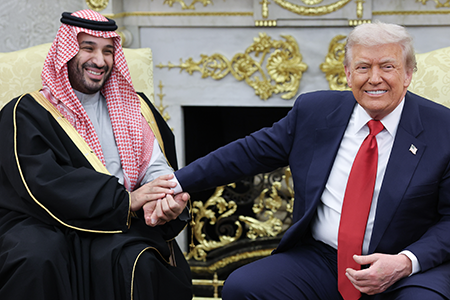
According to a Nov. 18 factsheet released by the White House, the two countries finalized a “Joint Declaration on the Completion of Negotiations on Civil Nuclear Energy Cooperation” during Saudi Arabian Crown Prince Mohammed bin Salman’s Nov. 18 meeting with U.S. President Donald Trump at the White House.
According to the statement, the declaration “builds the legal foundation for a decades-long, multi-billion-dollar nuclear energy partnership” and confirms that “the United States and American companies will be [Saudi Arabia’s] civil nuclear cooperation partners of choice.” The cooperation will be consistent with “strong nonproliferation standards,” the factsheet said.
Saudi Arabia is currently soliciting bids for two large nuclear power reactors and has expressed its intention to develop the entire nuclear fuel cycle, including enriching uranium and fabricating reactor fuel. (See ACT, March 2023.)
The United States has long sought to prevent the spread of enrichment and reprocessing because the technologies can be used to produce fissile materials for nuclear weapons. The issue of enrichment has stalled U.S.-Saudi nuclear negotiations for years, in part because Saudi Arabia has openly threatened to develop nuclear weapons.
In September 2023, bin Salman said that if Iran acquires a nuclear weapon, “we have to get one.” (See ACT, November 2023.) As a party to the nuclear Nonproliferation Treaty (NPT), Saudi Arabia is prohibited from developing or acquiring nuclear weapons.
U.S. Secretary of Energy Chris Wright said in a Nov. 19 interview on Fox News that the joint declaration is just for “American technology, American companies to build a very large nuclear power plant in Saudi Arabia.” He said there is “no enrichment” in the deal. It is unclear, however, if Wright was referring to the joint declaration or the final nuclear cooperation agreement, known as a “123 agreement,” that the Trump administration will need to share with Congress before certain technologies and materials can be transferred. The 123 agreements that meet certain criteria do not require congressional approval but can be subjected to a vote of disapproval. Agreements that do not meet certain criteria require a vote of approval. It is unclear yet what will happen in this case.
Section 123 of the Atomic Energy Act lays out the conditions for congressional approval. These include implementing safeguards, refraining from using transferred materials or technologies for developing a nuclear-explosive device, and obtaining advance U.S. consent before enriching or reprocessing nuclear materials transferred under the deal or producing nuclear materials using technology transferred under the terms of the agreement.
Following the announcement of the joint declaration, the chairman of the Senate Foreign Relations Committee, Senator Jim Risch (R-Idaho) and the ranking member, Senator Jeanne Shaheen (D-N.H.), said separately that any 123 agreement with Saudi Arabia should be a “gold standard” agreement, which includes a prohibition on uranium enrichment and plutonium reprocessing.
Under a gold standard agreement, a state is also required to implement an additional protocol to its legally required safeguards agreement. Saudi Arabia has not negotiated an additional protocol with the International Atomic Energy Agency (IAEA).
It is unclear if the Nov. 18 joint declaration includes a requirement that Saudi Arabia implement the additional protocol. In a Nov. 19 statement, Wright said there would be “bilateral safeguard agreements,” suggesting that the United States and Saudi Arabia might negotiate a separate monitoring agreement.
Saudi Arabia would still be required, however, to implement its comprehensive safeguard agreement with the IAEA under the NPT.
U.S. President Donald Trump said he hoped to meet with North Korea’s leader in the “not-too-distant future,” but a senior North Korean official said the Trump administration should not expect its pressure to yield results.
December 2025
By Kelsey Davenport
U.S. President Donald Trump said he hoped to meet with North Korean leader Kim Jong Un in the “not-too-distant future,” but a senior North Korean official said the Trump administration should not expect its intensifying pressure on Pyongyang to yield results.
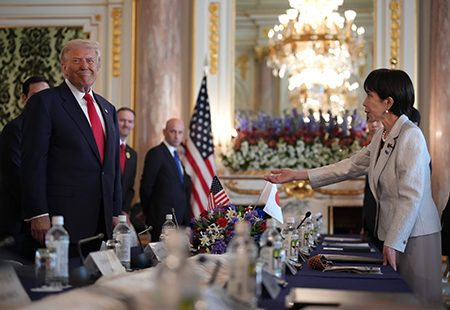
Speaking to reporters after an Oct. 29 meeting with South Korean President Lee Jae-Myung, Trump said he will do what he can to get the relationship between North and South Korea “straightened out” and downplayed North Korea’s recent missile tests. He suggested that he would use the lure of relief from U.S. sanctions to bring Kim to the negotiating table.
Trump said he was willing to meet with Kim during his trip to Asia in October, but it is unclear if his administration attempted to set up a meeting.
North Korea has not ruled out negotiating with the United States, but Kim has said multiple times that Washington must drop its demand for denuclearization before talks commence. (See ACT, October 2025.)
Trump and Lee, however, reaffirmed the U.S. and South Korean commitment to the denuclearization of North Korea, according to a Nov. 13 White House factsheet on the meeting. The factsheet also stated that South Korea and the United States pledged to “work together to implement” the Singapore Declaration from Trump’s meeting with Kim in 2018. (See ACT, July/August 2018.) In addition to the commitment to denuclearize the Korean peninsula, Kim and Trump pledged to build a lasting and stable peace regime in the region.
A Nov. 18 report by the North Korean news service KCNA criticized the Lee-Trump meeting and said the reference to denuclearization in the Nov. 13 factsheet proves “their only option is confrontation” with North Korea. It also said the 2018 agreement was “scrapped and nullified.”
The commentary accused South Korea and the United States of “anti-DPRK moves and escalation of tensions” and said these views “became more blatant since the emergence” of the second Trump administration.
In an earlier Nov. 6 KCNA statement, Vice Foreign Minister for U.S. Affairs Kim Un Chol criticized the U.S. pressure campaign in response to a U.S. announcement of new sanctions designations targeting North Korea’s illicit financing networks. He said the United States “should not expect or desire to see its own mode of dealing, which is full of pressure, appeasement, threat, and blackmail, working on [North Korea] someday.”
In a Nov. 4 press release, the U.S. Treasury Department announced the new sanctions, which target eight individuals and two entities for laundering money that North Korea acquired illicitly, primarily in cryptocurrency. The U.S. undersecretary of the Treasury for terrorism and financial intelligence, John K. Hurley, said that “North Korean state-sponsored hackers steal and launder money” to fund the country’s nuclear weapons program. The sanctioned entities and individuals “directly threaten U.S. and global security” by generating revenue for North Korea, he said.
“North Korea-affiliated cybercriminals have stolen over $3 billion” in the past three years, according to the department’s press release, which also noted that the illicit networks targeted by the new sanctions have ties to China and Russia.
Kim Un Chol said the “U.S. sanctions will have no effect on [North Korea’s] thinking” and that it is a “foolish move” to expect a “new result” from sanctions policy. The Trump administration has “clarified its stand to be hostile” toward North Korea, so Pyongyang will “take proper measures to counter” the United States, he said.
The Nov. 18 commentary also criticized U.S.-South Korea military drills. The frequent strategic drills prove that “the U.S. intention is to be hostile” toward North Korea and that sentiment “remains unchanged” with the new U.S. administration.
U.S. Secretary of Defense Pete Hegseth’s trip with South Korean Defense Minister Ahn Gyu-back to the demilitarized zone (DMZ) between North and South Korea also prompted backlash that suggested North Korea is not interested in diplomacy at this time.
In a Nov. 8 statement in KCNA, North Korean Defense Minister No Kwang Chol said that the visit was meant to “fan up war hysterics” and that Hegseth and Ahn “conspired” to strengthen deterrence against North Korea and rapidly promote “the process of integrating the nuclear forces with the conventional forces.”
No described the visit as “an unveiled intentional expression of [the U.S.-South Korea] hostile nature to stand against” North Korea, to which the state “will show more offensive action against the enemies’ threat.”
Ahn said the DMZ trip had a “declarative significance” and demonstrates the “strength of the South Korea-U.S. alliance and the strength of our combined defense posture.”
But South Korea’s acquisition of those capabilities would also give the country the ability to produce fissile material for nuclear weapons, raising the risk of proliferation.
December 2025
By Kelsey Davenport
U.S. President Donald Trump pledged support for South Korea to enrich uranium and separate plutonium, a move Seoul says is necessary to advance its civil nuclear program.
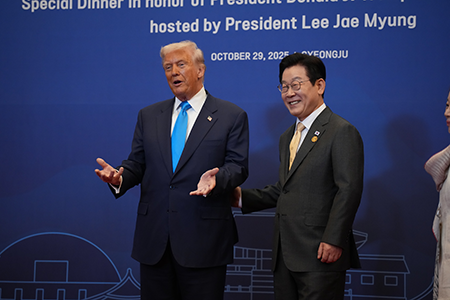
But South Korea’s acquisition of those capabilities would also give the country the ability to produce fissile material for nuclear weapons, raising the risk of proliferation at a time when there is an active debate in Seoul over the value of a national nuclear deterrent.
According to a Nov. 13 White House factsheet about Trump’s Oct. 29 meeting with South Korean President Lee Jae-Myung, the United States “supports the process that will lead to [South Korea’s] civil uranium enrichment and spent fuel reprocessing for peaceful uses.”
South Korea has long sought approval from the United States to develop enrichment and reprocessing capabilities. It argues that reprocessing spent fuel is necessary to manage nuclear waste produced by its energy reactors and that having the option to provide enriched uranium fuel for South Korean-built reactors, including those in foreign countries, also will benefit U.S. nuclear companies that partner with South Korea.
Until now, the United States has denied South Korea’s requests, consistent with Washington’s long-standing bipartisan policy to prevent the spread of enrichment and reprocessing technologies because of the risk that a state will use those capabilities to produce fissile materials for weapons.
The Nov. 13 factsheet does say that any enrichment and reprocessing must be consistent with the bilateral “123 agreement” between the two countries, suggesting the United States will press for limits on those capabilities.
Nuclear cooperation agreements are referred to as 123 agreements because Section 123 of the U.S. Atomic Energy Act lays out the conditions for cooperation and the congressional review process. Section 123 obligations include commitments that any state receiving certain U.S. nuclear technologies implement a comprehensive safeguards agreement with the International Atomic Energy Agency and obtain advance U.S. consent before enriching or reprocessing nuclear materials transferred under the deal or produced by technology transferred under the deal.
Seoul originally agreed to forgo enrichment and reprocessing when it signed a nuclear cooperation agreement with Washington in 1972, but it pushed to revisit the issue when the agreement was renewed in 2015. (See ACT, July/August 2015.)
The 2015 agreement did not give consent for enrichment and reprocessing, but it did create a pathway for Seoul to develop those technologies. The final 2015 agreement included the formation of a high-level bilateral commission to identify “appropriate options for uranium enrichment.” If the commission identifies a “mutually acceptable option” for enrichment, the agreement limits South Korea to enriching up to 20 percent uranium-235, a level below the 90 percent U-235 considered weapons grade.
The commission is also tasked with “identifying appropriate options for the management and disposition of spent fuel,” including the results of the joint fuel study on the feasibility of pyroprocessing and determining if South Korea can reprocess spent nuclear fuel.
Presumably, the commission would need to determine and define the contours of a mutually acceptable enrichment and reprocessing program in South Korea; the commission would likely do so now, given Trump’s public pledge of support. South Korean National Security Advisor Wi Sung-lac said in a Nov. 14 press briefing that “follow-up consultations are necessary to adjust our existing agreement.” Wi said the details will be negotiated.
In December 2024, the Biden administration’s Energy Department designated South Korea a “sensitive country,” a
term used for states that pose a proliferation risk. At the time, the since-removed South Korean President Yoon Suk Yeol was being impeached for declaring martial law. Yoon had suggested that South Korea may need to pursue nuclear weapons to deter North Korea.
Current President Lee is not calling for nuclear weapons development, but there is still an active debate in South Korea regarding the security value of nuclear weaponization. South Korea also has developed ballistic missiles powerful enough to deliver a nuclear warhead and built an advanced nuclear industry that it could leverage if the decision were made to develop nuclear weapons.
Under Section 123 of the Atomic Energy Act, the United States can demand the return of nuclear materials and equipment transferred under a nuclear cooperation agreement if the recipient state uses them for military purposes or an explosive device, but that would be challenging to enforce and could come too late.
North Korea responded to the announcement by accusing the United States of giving South Korea the “green light” to become a “quasi-nuclear weapons state” in a Nov. 18 commentary in the state-run Korean Central News Agency (KCNA).
Trump also announced U.S. support for South Korea’s plan to build nuclear-powered attack submarines in an Oct. 30 Truth Social post. Trump, who was in South Korea at the time, said that he gave South Korea “approval to build a Nuclear Powered Submarine” and suggested it would be better than the “old fashioned, and far less nimble diesel powered Submarines” that South Korea currently operates.
But the initial announcement stirred confusion when Trump suggested the submarines would be built in the United States, at a Korean-owned Pennsylvania shipyard that has no experience with nuclear-powered submarines. Lee, however, said the submarines will be built in South Korea. South Korean Defense Minister Ahn Gyu-back said the shipyard Trump referenced lacks the capabilities to build submarines. Ahn said South Korea has “accumulated technology” and research necessary to build the submarines domestically.
The Nov. 13 factsheet did not contain details on the location of construction. It said the “United States will work closely with [South Korea] to advance requirements for this shipbuilding project, including avenues to source fuel.”
During a Nov. 14 press briefing, Lee described the nuclear powered submarines as “a decades-long aspiration for South Korea and an essential strategic asset for peace and stability on the Korean peninsula.”
Ahn suggested in a Nov. 3 press briefing that “as long as fuel is available,” South Korea could construct its first nuclear-powered submarine in 10 years.
Ahn’s comment and the Nov. 13 factsheet suggest that South Korea will not enrich the fuel domestically for the reactor cores. South Korean Chief of Naval Operations Adm. Kang Dong-gil said the ships will be fueled with uranium enriched to less than 20 percent U-235, the upper limit allowed South Korea under the existing nuclear cooperation agreement. That agreement, however, prohibits South Korea from using any nuclear material transferred or produced under the deal “for any military purposes.”
U.S. naval nuclear-powered vessels, including U.S. nuclear-powered submarines, are fueled with above weapons-grade enriched uranium, or uranium enriched above 90 percent U-235.
North Korean leader Kim Jong Un probably will “not sleep well” given the stealth and speed of nuclear-powered submarines, Ahn said.
In the Nov. 18 KCNA commentary, North Korea said the U.S. decision to support South Korea’s development of nuclear-powered submarines is “disregarding the danger of the global nuclear arms race to be incurred by the nuclear proliferation to a non-nuclear state.”
North Korea first announced it was developing a nuclear-powered submarine in 2021.
The U.S. Defense Department is reforming how it acquires weapons systems by loosening restrictions on defense contractors and emphasizing speed over other requirements, promising a transformational improvement to a widely criticized status quo.
December 2025
By Xiaodon Liang
The U.S. Department of Defense is reforming how it acquires weapons systems by loosening restrictions on defense contractors and emphasizing speed over other requirements, promising a transformational improvement to a widely criticized status quo.
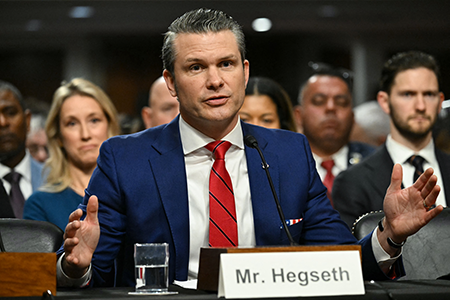
The reforms, announced by Secretary of Defense Pete Hegseth in a Nov. 7 speech at the National War College, reflect decades of dissatisfaction with the performance of the multibillion-dollar defense acquisition system, and builds on proposals accumulated in recent studies.
The effort will depend not only on successful implementation and congressional support, but also on some important untested assumptions—such as the ability of competition to cure other ills of the contracting relationship—proving to be true.
The department will encourage the use of less-regulated acquisition agreements, reduce oversight of contractor prices, grant officials greater flexibility for reallocation of funds across portfolios of capabilities, emphasize speed over other requirements, and make further changes to acquisition processes in a new round of reforms, Hegseth said.
“We’re talking here about transformation, not toothless reform and we’re seeking it fast,” he said after acknowledging past attempts at changing the department’s processes, in which Pentagon civilian leaders, military service chiefs, Congress, defense contractors, and other interests have long competed for influence over decisions and dollars.
The announcement, followed by a Nov. 10 acquisition strategy report and a set of departmental memoranda, comes as congressional staff finalize changes to acquisition statutes in conference negotiations on the fiscal 2026 defense authorization bill. In addition, the Pentagon has begun extending alternative acquisition methods to nuclear and strategic systems, such as the nuclear-capable, sea-launched cruise missile and some missile-defense programs. (See ACT, November 2025.)
In May, the Pentagon issued a request for industry to provide prototype proposals for the new sea-launched cruise missile through an alternative acquisition method known as an Other Transaction Authority (OTA) agreement. Since Congress made permanent the Pentagon’s ability to use this acquisition option in the fiscal 2016 defense policy bill, department spending on OTAs to procure prototypes has grown and then stabilized in the last few years at around $10 to $15 billion annually, according to a Sept. 3 report by the Government Accountability Office (GAO).
“The jury is still out on whether [OTAs] actually produce better outcomes” in defense contracting, Greg Williams of the Project on Government Oversight wrote in an Oct. 1 analysis.
Nevertheless, an Apr. 9 White House executive order set a “general preference” for OTAs and the Pentagon’s new acquisition strategy directs their use when “in the best interest of the warfighter and the taxpayer.”
OTA agreements are not contracts and do not require compliance with some federal acquisition regulations, including cost-accounting practices. These exemptions allow for more flexible agreements—and potentially faster negotiations—at the discretion and judgment of acquisition officials, while creating some contracting risk for the government.
The authority to enter into prototype OTA agreements is limited to deals with nontraditional contractors—firms that have not had to implement Pentagon-mandated cost-accounting standards within the last year as part of a contract—or deals incorporating a cost-sharing agreement with the government.
Consortia involving nontraditional and traditional contractors are also eligible, although the GAO found that the use of consortia can prevent aggregated reporting of the proportion of work actually performed by nontraditional companies. On Aug. 22, the Naval Surface Warfare Center issued awards to four traditional defense contractors and only one nontraditional firm for prototype work on the sea-launched cruise missile through a consortium managed by National Security Technology Accelerator, an intermediary company.
Provisions in both the House and Senate versions of this year’s defense authorization bill would loosen eligibility restrictions, allowing greater participation in OTAs by traditional firms.
It remains unclear whether OTAs are subject to bid protests from the losing side of an award—a risk that can add years to an acquisition process. In February, a judge of the U.S. Court of Federal Claims ruled that OTAs fell under his jurisdiction in a case brought by defense contractor Raytheon against the U.S. government and Northrop Grumman over the award of an OTA agreement for the development of an interceptor for glide-phase hypersonic missile threats.
That decision is not binding on other judges of the court until the issue is taken up by the federal circuit court.
Meanwhile, the Pentagon is also seeking to reduce the use of specialized cost-accounting standards altogether. These standards traditionally have granted the government greater insight into contractor prices but are opposed by industry as intrusive and burdensome.
The Nov. 10 acquisition strategy supports aligning government accounting standards with civil-economy equivalents while raising the dollar threshold of Pentagon contracts over which rigorous cost-accounting standards are required.
“While Pentagon contractors may claim that they find [government accounting standards] to be burdensome, they provide the government critical insight into the costs of performing a government contract,” Julia Gledhill, a research analyst at the Stimson Center wrote in a Mar. 13 analysis for Breaking Defense.
“Without these standards, the government, on behalf of American taxpayers, would not be able to meaningfully challenge contractors when they engage in overcharging,”she warned.
The Pentagon’s new acquisition strategy claims that, as the department pivots toward promoting more competition among suppliers, “the competitive pressures of the market will provide inherent cost and quality management,” even in the absence of intrusive cost accounting.
In general, the Pentagon now seeks to promote “competition with lowered barriers to entry and diversification of prime and subcontractor sourcing without sacrificing quality.” One instance of this focus on competition is a new directive to minimize formal analyses of alternatives in favor of competitive prototyping.
But although the department has now been ordered to adopt a “two-to-production standard”—maintaining competing suppliers at least up to initial production—the requirement is heavily caveated to apply only “where affordable and appropriate” and “unless waived by the respective” military service officials.
The Sentinel intercontinental ballistic missile acquisition effort became a sole-source program in 2019 after Boeing decided not to bid on the engineering and manufacturing design contract. (See ACT, September 2019.) The missile program would later overrun a 2020 cost estimate by 81 percent.
Another significant change the Pentagon announced Nov. 10 is a shift from top-level acquisition officials managing one program to, instead, managing a portfolio of programs that either provide similar capabilities or multiple components of related systems. This reorganization would allow these new officials, to be known as portfolio acquisition executives, to make trade-offs across programs as they mature.
The Senate version of the defense authorization bill has endorsed the concept of portfolio acquisition executives, while the House version remains silent on the matter.
The acquisition strategy also emphasizes incentivizing the timely delivery of weapons systems, promising contracts that reward early delivery and penalize delays.
According to Todd Harrison, a senior fellow at the American Enterprise Institute, although Hegseth is emphasizing speed, “What he’s not saying is, ‘I’m willing to accept higher costs and lower performance.’ But that is the reality, that when you prioritize one, you’re making sacrifices in one or both of the others,” Harrison said in Nov. 4 comments to Breaking Defense.
One way the Pentagon will seek deployment of capabilities on faster timelines is through a preference for “iterative enhancement and rapid delivery of subsequent increments,” according to a departmental memorandum.
This approach has been championed in recent years by some niches of the military acquisition ecosystem, such as the Space Development Agency, which acquires tranches of incrementally improved satellites for the Pentagon’s nascent military constellations. But the approach has also yielded notable failures, including the Ground-Based Interceptor missile defense program that currently deploys several combinations of iteratively developed boosters and kill-vehicles, each with different testing records.
The International Atomic Energy Agency Board of Governors passed a resolution urging Iran to fully implement safeguards on its nuclear program and provide information about its stockpile of enriched uranium.
December 2025
By Kelsey Davenport
The International Atomic Energy Agency (IAEA) Board of Governors passed a resolution urging Iran to fully implement safeguards on its nuclear program and provide information about its stockpile of enriched uranium. The move prompted Iran to formally cancel an agreement with the agency on a process for resuming safeguards at nuclear facilities targeted by Israeli and U.S. strikes in June (See ACT, October 2025.)

Nineteen of the board’s 35 members voted in favor of the resolution, which was sponsored by France, Germany, the United Kingdom, and the United States. China, Niger, and Russia voted against it, and 12 members abstained.
According to the Nov. 20 resolution, Iran “must comply fully and without qualification” with its safeguards agreement, as required by the nuclear Nonproliferation Treaty. The resolution also urges Iran “to extend full and prompt cooperation to the IAEA.”
Iran suspended cooperation with the IAEA after Israeli and U.S. strikes on its nuclear facilities in June. (See ACT, July/August 2025.) Tehran has since allowed the IAEA to return to undamaged facilities, such as its Bushehr nuclear reactor, but has yet to provide access or information about the damaged sites or Iran’s stockpile of enriched uranium.
In a Nov. 19 statement issued on behalf of the four sponsoring states, UK Ambassador to the IAEA Corinne Kitsell said, “Our message is clear: Iran must resolve its safeguards issues without delay.”
Kitsell told the board that the resolution “requests no more than what Iran is already legally obligated to provide: unhindered access, precise information on nuclear material accountancy and safeguarded nuclear facilities, and restoration of necessary monitoring arrangements.”
Iranian Ambassador to the IAEA Reza Najafi said in a Nov. 20 press conference that the resolution “will have its own consequences.”
Iranian Foreign Minister Abbas Araghchi later announced that Iran notified the agency that a Sept. 9 agreement reached between the IAEA and Iran on a process for resuming safeguards at sites struck in June “is considered terminated.” Araghchi said the resolution “disrupted the process of interactions and cooperation” between the agency and Iran.
Iran had previously announced that the deal, known as the Cairo Agreement, was void, but had not formally notified the IAEA, according to a Nov. 12 agency report on Iran’s nuclear program. The report said Iran had not taken any steps to implement the Cairo agreement.
Although Iranian officials have stated that the country is no longer enriching uranium because of the damage done to its enrichment facilities at Natanz and Fordow, it is likely that Iran’s stockpile of uranium enriched to 60 percent uranium-235, which is nearly the 90 percent U-235 considered weapons grade, survived the June strikes.
IAEA Director-General Rafael Mariano Grossi told the board Nov. 19 that IAEA access to Iran’s nuclear materials to verify the inventories is “long overdue” and “needs to be addressed urgently.” The Nov. 12 report on Iran’s nuclear program said access to the enriched uranium is critical to allay concerns “regarding the possible diversion of declared nuclear material from peaceful uses.”
The status of Iran’s enriched uranium is a particular concern because the 60 percent U-235 material technically can be used for a bomb, but the device would be large and unwieldy. It is more likely Iran would quickly enrich the material to weapons-grade levels, or 90 percent U-235.
Some centrifuges, the machines used to enrich uranium, also likely survived the military strikes, possibly at an enrichment facility that the IAEA never visited.
The Nov. 12 report noted that the IAEA does not know the “precise location” of the uranium enrichment facility at Esfahan that Iran declared just prior to the Israeli attack, whether it was affected by the strikes, or whether it “contains nuclear material.” The IAEA was set to visit the facility on June 13, the day the Israeli strikes began.
Although the IAEA reports raise serious concerns about Iran’s nuclear program, neither the United States nor Iran appears in a hurry to resume nuclear negotiations, and comments from officials in both countries suggest they remain far apart on the scope of talks.
In a Nov. 19 press conference, President Donald Trump said the United States “obliterated [Iran’s nuclear program] very quickly and very powerfully” and now Iran wants to “work out a deal with us.” U.S. officials stated previously that any agreement with Iran must prohibit uranium enrichment. (See ACT, October 2025.)
Kamal Kharrazi, an advisor to Iran’s supreme leader, told CNN in a Nov. 19 interview that Iran is willing to negotiate, but the United States has to “make the first move to show that they are ready to engage” on a basis of mutual respect. He said there must be “clarity of substance and the process of discussions,” and noted that Iran will only discuss nuclear issues with the United States. Iran’s missile program is not negotiable, Kharrazi said.
Kharrazi, however, appeared to raise doubt about whether Trump could meet those conditions. He said Trump “does not believe in diplomatic engagement.”
Kharrazi also highlighted that uranium enrichment remains a sticking point. He said Iran will negotiate the “degree of enrichment” but not enrichment itself. Trump is calling for a prohibition on enrichment in any future deal.
Iranian Foreign Minister Abbas Araghchi made a similar point during remarks to the Tehran Dialogue Forum Nov. 16. He said Iran’s “right to enrichment … is undeniable” and Iran “would never give up [its] rights.”
“The U.S. cannot expect to gain what it couldn’t in war through negotiations,” he said.
Belgium is conducting multiple criminal investigations after 17 recent unexplained drone sightings over its airports, nuclear power plants, and military sites. NATO countries fear such flights could be testing allied defenses.
December 2025
By Shaghayegh Chris Rostampour
Belgium is conducting multiple criminal investigations after 17 recent, unexplained drone sightings over its nuclear power plants, military sites, and airports.
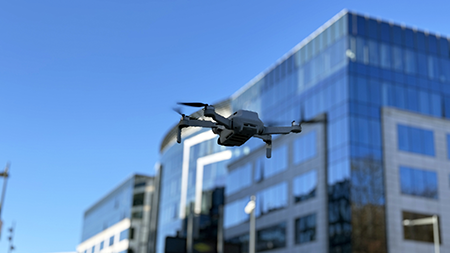
A spokesperson for Belgium’s federal prosecutors suggested that the problem escalated to the federal level due to signs of possible foreign interference. “Initially, we contact local police and prosecutors. If there are indications of espionage or interference, it will be federalized,” Yasmina Vanoverschelde told The Brussels Times Nov. 5.
Belgian Defense Minister Theo Francken confirmed Nov. 2 that a series of unidentified drone flights were observed near the Kleine-Brogel air base, which is believed to host U.S. nuclear weapons. He described the incidents as coordinated and resembling a spying operation. “By whom, I don’t know. I have a few ideas but I’m going to be careful about speculating,” he said.
But on Nov. 28, the Dutch newspaper Trouw reported that the drone alerts frequently were false alarms and revealed scant hard evidence of Russian involvement.
Additional drone sightings near the two main airports around Brussels led to temporary shutdowns Nov. 6 and Nov. 10. “At first, drones flying over our military bases were seen as our problem. Now it has become a serious threat affecting civilian infrastructure across multiple European countries,” Francken said in a Nov. 7 interview with the BBC.
NATO countries have expressed concern that such flights could be testing allied defenses. German Defense Minister Boris Pistorius linked the Belgian drone incursions to tensions over Russia’s war on Ukraine, its hybrid warfare tactics, and NATO’s consideration of using Russian frozen assets to further help defend Ukraine.
Reuters reported Nov. 10 that France, Germany, and the United Kingdom have sent experts and equipment to Belgium to help combat the drones. Addressing Belgium’s parliament, Francken announced Nov. 13 that the United States has offered “technical and operational assistance.”
Russia has denied any involvement with the drone incursions; the Russian embassy in Brussels said in a Nov. 5 statement on social media that it had “neither interest nor motive” in such activities.
Russia has been blamed for several recent airspace violations, notably in Poland and Estonia, prompting alliance security consultations under Article 4 of the North Atlantic Treaty. (See ACT, October 2025 and September 2025.) In response, NATO announced a multidomain operation Sept. 12 to “bolster NATO’s posture along the eastern flank.” At a press conference that day, NATO Secretary-General Mark Rutte said that although the operation followed Poland’s request under Article 4, “what happened on Wednesday was not an isolated incident. Russia’s recklessness in the air along our eastern flank is increasing in frequency.”
On Nov. 25, the Romanian Defense Ministry announced that NATO jets intercepted two Russian drones that had crossed into the country’s airspace from Ukraine, following missile and drone strikes between Russia and Ukraine. Moldova, a non-NATO European country, separately announced having detected six drones in its airspace, including one aerial vehicle that then traveled toward Romania.
Recent large-scale drone strikes, including Ukraine’s “Spiderweb” offensive against Russian strategic assets in June, have alarmed military planners worldwide. These events illustrate how emerging unmanned technologies are enabling new forms of asymmetric warfare, forcing a reevaluation of the security of high-value military assets, including the potential vulnerability of NATO allies’ own nuclear forces. (See ACT, July/August 2025.)
“Drones are already redefining warfare. Having drone defenses is no longer optional for anyone,” European Commission Vice President Kaja Kallas said at a press conference in Brussels Nov. 20.
She added that the European Union is developing a new anti-drone defense system “in close coordination” with NATO that is expected to be fully operational by the end of 2027.
Ukraine is also set to receive a French-made, first-of-its-kind “drone wall,” guided by artificial intelligence, that is designed to intercept incoming munitions from Russia. Speaking to Business Insider Nov. 12, the manufacturer described the new defense as a “flying drone minefield.” The system is expected to be deployed within the next few weeks.
Members of the UN General Assembly’s First Committee voted overwhelmingly to approve two resolutions calling for greater international scrutiny of the risks posed by the military use of AI, with Russia and the United States in notable opposition.
December 2025
By Michael T. Klare
Members of the UN General Assembly’s First Committee voted overwhelmingly to approve two resolutions calling for greater international scrutiny of the risks posed by the military use of AI, with Russia and the United States in notable opposition.
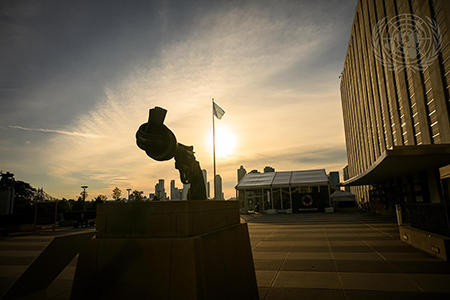
The two resolutions adopted Nov. 6 constitute pioneering efforts by UN member states to better comprehend the consequences of using AI for military purposes, especially in the nuclear realm.
One resolution, on “artificial intelligence in the military domain and its implications for international peace and security,” first introduced in 2024, addresses the larger picture of AI weaponization and was approved 166-5 with five abstentions; the other, on “possible risks of integration of artificial intelligence into command, control and communication systems of nuclear weapons,” focuses on that particular aspect of the problem. It was approved 115-8 with 44 abstentions.
The measures have been submitted to the full General Assembly, which is almost certain to approve them by the end of the year.
The adoption of these proposals by the First Committee, which is responsible for security and disarmament affairs in the General Assembly, reflects growing international concern over the exploitation of AI for military purposes. (See ACT, November 2025.) Many experts have warned that without effective safeguards, AI-enabled systems could bypass or eliminate human control over the use of force, causing substantial death and destruction and possibly triggering the use of nuclear weapons. (See ACT, June 2024.) This, in turn, has sparked calls for the imposition of international controls on the use of AI in combat systems.
“Humanity’s fate cannot be left to an algorithm,” UN Secretary-General António Guterres told a Sept. 24 session of the UN Security Council devoted to AI and international security. “Humans must always retain authority over life-and-death decisions,” Guterres added.
The two resolutions incorporate these concerns and call on member states to work together in identifying the dangers posed by the military use of AI and in devising safeguards to avert those perils.
Resolution A/80/46 urges states to “pursue national, regional, subregional and global efforts to address the opportunities and challenges, including from humanitarian, legal, security, technological and ethical perspectives, related to the application of artificial intelligence in the military domain.” It also authorizes the secretary-general to organize a three-day gathering of member states in 2026 to exchange views on this topic and to consider next steps to address the dangers involved. The UN Office for Disarmament Affairs is charged with preparing a summary of these deliberations for consideration at the next General Assembly meeting, in fall 2026.
The United States voted in favor of a similar resolution in 2024, but this time voted “no,” along with Burundi, Israel, North Korea, and Russia. Explaining its vote, the U.S. delegation claimed that the resolution “risks starting down the unwelcome and unhelpful path of creating a global governance regime designed to institute centralized control over a critical technology.”
This outlook is consistent with President Donald Trump’s call for U.S. victory in what he has termed a “race” to achieve “global dominance in artificial intelligence.” It also reflects claims by leaders of the commercial tech industry that international controls on AI, however mild, pose a threat to their unbridled development of advanced AI models.
Consistent with this outlook, the United States also voted “no” on the second resolution, A/80/56, concerning the potential dangers arising from the integration of AI into nuclear command-control-and-communications (NC3) systems.
This measure represents the General Assembly’s first attempt to address these risks. Many experts, including former military officials, have warned that the unrestrained integration of AI into NC3 could result in the “poisoning” of nuclear decision-making systems by false or corrupted data, leading to hasty or misguided nuclear launch decisions. (See ACT, September 2025.)
The resolution seeks to diminish this risk by encouraging member states to jointly explore the unique dangers created by the integration of AI into NC3 systems. It also calls on the nuclear-armed states to take immediate steps to ensure that humans, not machines, exercise ultimate control over the use of nuclear weapons.
The U.S. Defense Nuclear Facilities Safety Board will continue its work at limited capacity despite the loss of a quorum earlier this year after a board member stepped down
December 2025
By Lipi Shetty
The U.S. Defense Nuclear Facilities Safety Board (DNFSB) will continue its work at limited capacity despite the loss of a quorum earlier this year after a board member stepped down. The essential ongoing evaluations on the board’s agenda include safety considerations at Los Alamos National Laboratory’s PF-4 Plutonium Facility, which was the focus of an Oct. 10 board report to the Department of Energy (DOE).
Since January, the five-person board had been reduced to two members: acting Chairman Thomas Summers and Patricia Lee. Summers’ second term as vice chairman and as acting chairman concluded Oct. 18, leaving Lee as acting chairman and the only remaining member of the board.
In an Oct. 17 letter to Energy Secretary Chris Wright, the board stated that it “assure[s] you that the Board’s dedicated staff will continue to execute the safety oversight mission as required by the Atomic Energy Act” despite loss of the quorum.
The letter also notes that Summers has delegated certain authorities to board staff, including the authority to issue reporting requirements.
“Past board recommendations have resulted in saving millions of dollars by preventing accidents and providing a basis to modify or not build facilities,” said the Alliance for Nuclear Accountability in a Sept. 11 letter. “Maintaining a Board quorum preserves the DNFSB’s ability to issue formal recommendations, impose reporting requirements, and conduct hearings, thus ensuring that DOE avoids accidents and remains accountable,” the coalition of nonprofit advocates said in the letter.
Nominees to the board must be appointed by the president and confirmed by the Senate. The board has sent a list of potential nominees to the White House.
In one of its last acts before losing a quorum, the board published Oct. 10 its review of the National Nuclear Security Administration’s safety analysis of the Los Alamos Plutonium Facility. The report concluded that the energy department is prioritizing capability upgrades to its plutonium facility over infrastructure safety concerns.
“DOE and [Los Alamos National Laboratories] should consider prioritizing safety-related infrastructure projects to ensure that the Plutonium Facility safety strategy adequately protects the public, as the facility takes on new and expansive national security missions,” the report said.
The report determined that several safety considerations at the facility “depend on assumptions that cannot be technically verified and are sometimes non-conservative.” Among infrastructure projects that have been delayed are glovebox system improvements and fire prevention systems for mitigating risks associated with seismic activities.
The board has “long advocated for the use of safety-related active confinement systems in nuclear facilities for the purposes of confining radioactive materials.” The Energy Department favors passive confinement systems, which may allow unfiltered air with radioactive material to be released following an accident.
The PF-4 plutonium facility is currently undergoing upgrades to meet the congressionally mandated production target of 30 plutonium pits per year by 2030. A first production unit of a plutonium pit for the W87-1 warhead was completed in October 2024.
Conference on Middle East WMD-Free-Zone Convenes
December 2025
International diplomats began another effort to advance a zone free of weapons of mass destruction in the Middle East when they met Nov. 17 in New York. The sixth session of the Conference on the Establishment of a Middle East Zone Free of Nuclear Weapons and Other Weapons of Mass Destruction, presided over by Morocco, is due to last through Nov. 21.
“The people of the Middle East deserve stability and peace, but the threat of nuclear weapons and other weapons of mass destruction is pushing this promise out of reach,” UN Secretary-General António Guterres said in an opening statement. “A zone free of these scourges would ease tensions and prevent the worst-case scenario from ever coming to pass.”
The goal of the annual conference is to negotiate a legally binding treaty to establish a weapons-of-mass-destruction-free zone in the Middle East, as mandated by 2018 General Assembly. The Arab League; Iran; Israel; four of the five nuclear-weapon states recognized under the nuclear Nonproliferation Treaty; and the members of the International Atomic Energy Agency and the Organization for the Prohibition of Chemical Weapons attended.
During the conference, member states called for greater engagement from nuclear weapons states. Previous sessions have laid the groundwork of substantive and procedural matters, with the fifth session focusing on development of an index of topics for future sessions.—LIPI SHETTY
